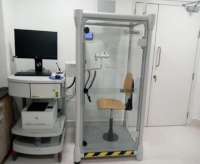Plethysmography in Nigeria: An Overview of the Indications, Equipment, Principle, Preparation, Procedure and Interpratation of Results.
Main Article Content
Abstract
Downloads
Article Details
Section

This work is licensed under a Creative Commons Attribution-NonCommercial-ShareAlike 4.0 International License.
This is an open-access article distributed under the terms ![]() This work is licensed under a Creative Commons Attribution-ShareAlike 4.0 International License.
This work is licensed under a Creative Commons Attribution-ShareAlike 4.0 International License.
How to Cite
References
1. Criée CP, Sorichter S, Smith HJ, Kardos P, Merget R, Heise D, Berdel D, Köhler D, Magnussen H, Marek W, Mitfessel H. Body plethysmography–its principles and clinical use. Respiratory medicine. 2011 Jul 1;105(7):959-71.
2. Goldman MD, Smith HJ, Ulmer WT. Whole-body plethysmography. European Respiratory Monograph. 2005 Apr 1; 31:15.
3. Stocks J, Godfrey S, Beardsmore C, Bar-Yishay E, Castile R, ERS/ATS Task Force on Standards for Infant Respiratory Function Testing. Plethysmographic measurements of lung volume and airway resistance. European Respiratory Journal. 2001 Feb 1;17(2):302-12.
4. de Mir Messa I, Prado OS, Larramona H, Posadas AS, Asensi JV. Body plethysmography (i): Standardisation and quality criteria. Anales de Pediatría (English Edition). 2015 Aug 1;83(2):136-e1.
5. Barisione G, Pellegrino R. Body plethysmography is helpful for COPD diagnosis, determination of severity, phenotyping, and response to therapy. COPD: Journal of Chronic Obstructive Pulmonary Disease. 2015 Nov 2;12(6):591-4.
6. Clausen JL, Coates AL, Quanjer PH. Measurement of lung volumes in humans: review and recommendations from an ATS/ERS workshop. European Respiratory Journal. 1997 Jun 1;10(6):1205-6.
7. Ayuk A, Ndukwu C, Uwaezuoke S, Ekop E. Spirometry practice and the impact of a phase 1 training workshop among health workers in southern Nigeria: a crosssectional study. BMC Pulmonary Medicine. 2020 Dec; 20:1-8.
8. Obaseki D, Adeniyi B, Kolawole T, Onyedum C, Erhabor G. Gaps in capacity for respiratory care in developing countries. Nigeria as a case study. Annals of the American Thoracic Society. 2015 Apr;12(4):591-8.
9. Coates AL, Peslin R, Rodenstein D, Stocks J. Measurement of lung volumes by plethysmography. European Respiratory Journal. 1997 Jun 1;10(6):1415-27.
10. Flesch JD, Dine CJ. Lung volumes: measurement, clinical use, and coding. Chest. 2012 Aug 1;142(2):506-10.
11. Bhakta NR, McGowan A, Ramsey KA, Borg B, Kivastik J, Knight SL, Sylvester K, Burgos F, Swenson ER, McCarthy K, Cooper BG. European Respiratory Society/American Thoracic Society technical statement: standardisation of the measurement of lung volumes, 2023 update. European Respiratory Journal. 2023 Oct 1;62(4).
12. Altalag A, Road J, Wilcox P, Aboulhosn K. Respiratory Muscle Function and Other Pulmonary Function Studies. Pulmonary Function Tests in Clinical Practice. 2019:99-118.
13. Goldman MD, Smith HJ, Ulmer WT. Whole-body plethysmography. European Respiratory Monograph. 2005 Apr 1; 31:15.
14. Peslin R, Papon J, Duviver C, Richalet J. Frequency response of the chest: modeling and parameter estimation. Journal of Applied Physiology. 1975 Oct 1;39(4):523-34.
15. Miller MR, Crapo R. Static Lung Volume. European Respiratory Journal.;26(3):511-22.
16. Miller MR, Crapo R, Hankinson J, Brusasco V, Burgos F, Casaburi R, Coates A, Enright P, van der Grinten CM, Gustafsson P, Jensen R. General considerations for lung function testing. European Respiratory Journal. 2005 Jul 1;26(1):153-61.
17. Graham BL, Steenbruggen I, Miller MR, Barjaktarevic IZ, Cooper BG, Hall GL, Hallstrand TS, Kaminsky DA, McCarthy K, McCormack MC, Oropez CE. Standardization of spirometry 2019 update. An official American thoracic society and European respiratory society technical statement. American journal of respiratory and critical care medicine. 2019 Oct 15;200(8):e70-88.
18. Mottram C, Kijek K, Roads J. Biologic quality control variability among pulmonary function testing systems across British Columbia. European Respiratory Journal. 2014 Sep 1;44(Suppl 58).
19. Wanger J, Clausen JL, Coates A, Pedersen OF, Brusasco V, Burgos F, Casaburi R, Crapo R, Enright P, Van Der Grinten CP, Gustafsson P. Standardisation of the measurement of lung volumes. European respiratory journal. 2005 Sep 1;26(3):511-22.
20. Stanojevic S, Kaminsky DA, Miller MR, Thompson B, Aliverti A, Barjaktarevic I, Cooper BG, Culver B, Derom E, Hall GL, Hallstrand TS. ERS/ATS technical standard on interpretive strategies for routine lung function tests. European Respiratory Journal. 2022 Jul 1;60(1).


